2019 Playoffs: The playoffs began with ten teams. Now there are four.
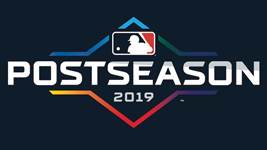
Oakland and Milwaukee dropped out quickly in the two sudden-death wild-card games. The AL wild-card winner was Tampa Bay, and in the NL, it was Washington.
In the NLDS, both series went the full five games, and each was won by the underdog. I sat down Wednesday afternoon to watch the Cardinals start Game 5 against Atlanta, and yadi, yadi, yadi, the Cards scored ten runs in the first inning. That play-by-play description is borrowed from Seinfeld’s yada, yada, yada, but with a nod to Card’s catcher Yadi Molina. The Cardinals went on to win 13-1.
In the other NLDS Game 5, the Dodgers held a 3-1 lead in the top of the seventh. The Nationals had two men on base with two outs when Dodger manager Dave Roberts brought in Clayton Kershaw to relieve. Knowing Kershaw’s poor history in postseason play, Pavlov’s dog would not have done this. Kershaw got the final out in the seventh, but then gave up back-to-back homers to start the eighth, tying the game at 3-3. Kershaw exited, but the damage was done. Embarrassingly, I fell asleep during the ninth inning and missed seeing Howie Kendrick’s grand slam that gave the Nationals a 7-3 victory in the tenth. So the 106-win Dodgers are out, and the wild-card team heads to the NLCS.
In the ALDS, the Yankees easily swept the Twins in three games, but the Houston-Tampa Bay series went the full five games. Last night, Gerrit Cole of the Astros pitched a gem to eliminate the Rays. The ALCS will now feature the top two teams from the regular season: Astros (107-55) and Yankees (103-59). In contrast, the top two winning teams from the NL are gone, leaving the Nationals (93-69) and Cardinals (91-71) to battle for the pennant.
Tampa Bay deserves a shout-out for taking the Astros to five games. The Rays also produced my favorite play in the postseason so far. Jose Altuve of the Astros attempted to score from first on a double, but a strong throw from the outfield and a perfect relay to the catcher broke up an Astros rally. See it here (2:39).

Now on to the ALCS and NLCS. With apologies to the many Cardinal fans who subscribe to Hot Stove, I have a soft spot for Washington to go all the way. The franchise started as the expansion Montreal Expos in 1969 and relocated to Washington in 2005. The team has never won a World Series – 50 seasons and counting. And doesn’t our nation’s capital deserve some good news?
As we wait for the winners in the next round, let’s take a look back at the Series played 100 and 75 years ago – 1919 and 1944. In the next Hot Stove, I’ll go back to 50 and 25 years ago – 1969 and 1994.
1919 – The Black Sox: It was quite a year. Prohibition started. Women got the right to vote. The Treaty of Versailles was signed (but not by the United States).
Most baseball fans know about another big story from 1919. The Chicago White Sox won the AL pennant and then eight of the Sox players conspired with gamblers to throw the World Series. What many fans do not remember is which team won that Series. It was the Cincinnati Reds who were playing in the Series for the first time. The Reds won five games to three (best of nine games, a format used only in 1903 and 1919-1921).
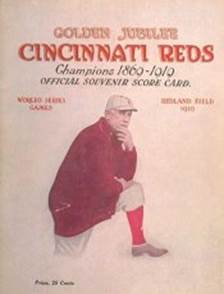
Although there were rumors about the Sox and gamblers, the 1920 season got underway with no action against the players. The White Sox again contended for the pennant and were a half game out of first place with three games to go when the work of the grand jury became public. Although no player was yet indicted, owner Charles Comiskey immediately suspended all players under investigation, and the depleted Sox were edged out for the 1920 pennant by the Cleveland Indians.
Eight indictments came down the following month, but all of the players were acquitted in a 1921 trial. Nevertheless, the newly appointed first Commissioner of Baseball, Judge Kenesaw Mountain Landis, banned the indicted players from organized baseball. A version of the story is told in the John Sayles movie Eight Men Out (based on a book of the same name). The film is a good period piece, but many of its storylines have been debunked (see the SABR article “Eight Myths Out”).

[Gangster Trivia: New York mobster Arnold Rothstein was implicated in the Black Sox scandal, but he denied involvement and was never indicted. His gangster life is well remembered by the entertainment world. He is featured in the movie Eight Men Out. He was a regular character in HBO’s Boardwalk Empire. In The Godfather: Part II, gangster Hyman Roth explains to Michael Corleone that he’s loved baseball ever since Arnold Rothstein fixed the 1919 World Series. In the real world, Arnold Rothstein was assassinated in 1928 after refusing to pay off a debt from what he claimed was a crooked poker game. In the Godfather world, Hyman Roth was assassinated on the order of Michael Corleone.]
After 1920, the elite status of the White Sox in the American League came to an end. They had won pennants in 1917 and 1919 and were a close second in 1920. With the loss of their banned players, the team became a perennial second division team. They suffered a forty-year drought until the “Go-Go Sox” of 1959, under the leadership of Bill Veeck, won the AL pennant (but lost the World Series to the Dodgers).
The demise of the White Sox coincided with the rise of the Yankees. In 1920, Babe Ruth was in his first year with the Yankees. He hit 54 home runs, serving notice that the dead-ball era was over and that the Bronx Bombers were coming. And quickly. The Yankees won the AL pennant the next three years and each time played the New York Giants in the World Series. The Giants won in 1921 and 1922, and the Yankees in 1923 (their first of 27 World Series wins).
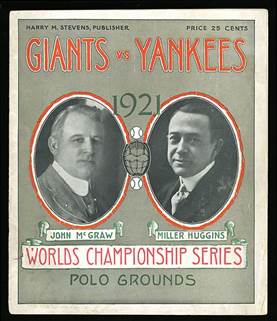
In 1921 and 1922, the home field for both teams was the Polo Grounds (the original Yankee Stadium opened in 1923). This meant that all World Series games in 1921 and 1922 were played on the same field. This has happened only one other time, in 1944…
1944 – The Trolley Series in Sportsman’s Park: For decades, the St. Louis Browns owned their own field – Sportsman’s Park. The Cardinals also played there, as a tenant of the Browns. In 1944, each team won the pennant in their respective league and they met in the World Series. This meant that all games of the “The Trolley Series” (aka “The St. Louis Showdown” and “The Streetcar Series”) were played at Sportsman’s Park.
Except for Chicago in 1906, this was also the only time that a city other than New York hosted all of a World Series. Yes, I know that the 1989 Series was all in the Bay Area, but that was two cities (Oakland and San Francisco). There has been one other All-Missouri World Series – 1985, Royals v. Cardinals.
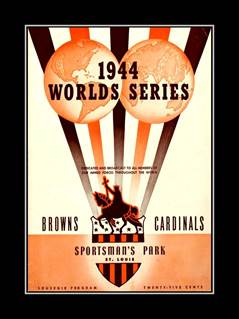
The Browns were known as perennial losers, but won the AL pennant in 1944 because many team rosters were depleted by the war. The Cardinals, perennial winners, were led by MVP Marty Marion and future Hall of Famer Stan Musial. The Cardinals won the Series in six games. For video highlights, click here (2 minutes).
Below, Game 1, Sportsman’s Park.
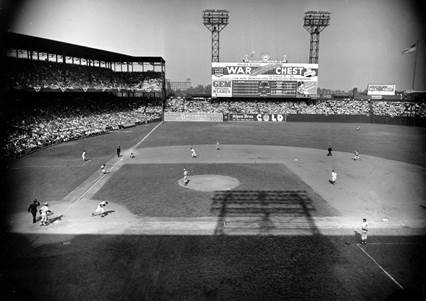
Below, Game 3, in the Browns dugout at Sportsman’s Park. The two politicos are Harry Truman (running for VP with President Roosevelt) and Phil Donnelly (Democratic candidate for Missouri governor). They both won in November. Just a few months later Truman would be President.
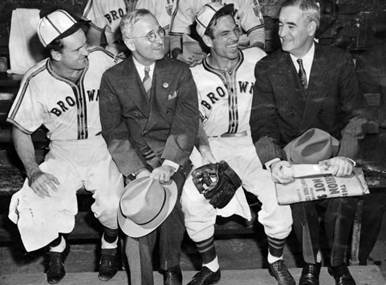
In 1951, Bill Veeck became the owner of the Browns. His promotions elevated the Browns in popularity and prompted the Cardinals to consider moving the team – St. Louis was likely too small to successfully support both franchises. But everything changed when Anheuser-Busch bought the Cardinals in 1953. Veeck could not compete with the deep pockets of Gussie Busch. Needing cash, Veeck sold Sportsman’s Park to the Cardinals in 1953, reversing the landlord-tenant relationship. Veeck gave up the battle and sold the Browns to a group that moved the team to Baltimore in 1954.
In their 52 seasons in St. Louis, the Browns won only one pennant (the one in 1944) and never won a World Series. In their 65 seasons since moving to Baltimore, the franchise has won six pennants and three World Series (1966, 1970 and 1981). The Cardinals have won 19 pennants and 11 World Series. Sportsman’s Park was replaced by Busch Memorial Stadium in May of 1966 (in turn replaced by Busch Stadium in 2006).
Lonnie’s Jukebox: A month after the 1944 Trolley Series, the movie Meet Me in St. Louis was released. It starred Judy Garland who sang the Oscar-nominated “Trolley Car Song” (Clang, clang, clang…see it here). Be sure to see Renee Zellweger channeling Judy in the movie Judy, now showing in local theaters. As noted in the recent Telluride Hot Stove, Renee was superb and will no doubt be nominated for Best Actress.

Joe Posnanski – Wild About Harry (Houdini): During the fall of 1919, when the White Sox became the Black Sox, Harry Houdini was in theaters in what is said to be his best movie, The Grim Game. It’s a 71-minute silent film available on YouTube.
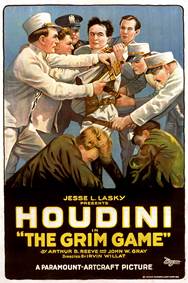
Why would I bring this up? Because of sportswriter Joe Posnanski. Most Royals fans are also fans of Posnanski because of his excellent coverage of the team in the Kansas City Star from 1996 to 2009. In all of his years covering the team for the Star, there was ONE winning season (2003, 83-79). For many of those years, Joe wrote a pre-season column that predicted (tongue firmly in cheek) that the Royals would win the pennant. He of course knew better. In 2011, two years after Joe left the Star, he wrote an article for Sports Illustrated that predicted that the Royals would win the World Series in 2015. This time he meant it – he was impressed by some of the young players and the talent in the farm system. And the Royals fulfilled his prediction by winning the Series four years later.
Many of us have continued to follow Joe as he has moved along in his career. His current gig is at The Athletic, a paid subscription site well worth the money (you can sign up here; this also gives access to all of the writers on the site, e.g. Ken Rosenthal and former KC Star sportswriters Rustin Dodd and Andy McCullough). Joe also does a periodic podcast: The Poscast with Joe Posnanski and Michael Schur. Schur is the clever creator of TV sitcoms Parks and Recreation, Brooklyn Nine-Nine and The Good Place. The podcasts are mostly about baseball and are hilarious. Sign up wherever you listen to podcasts.

Now back to Houdini. Joe has a new book that will be released on October 22. It has nothing to do with sports. But I will read it. Whatever Joe writes about – baseball, tennis, Hamilton, Buck O’Neil, etc. – it’s all great writing. The title of the book is The Life and Afterlife of Harry Houdini. It is a biography (the “life”) plus a story of the “wonder” of Houdini that remains with us nearly a century after his death (the “afterlife”). Houdini never had the benefit of Facebook, Twitter or the 24-hour news cycle, but his reach is still viral. Houdini is the name given to the pitcher who gets out of a of bases-loaded jam, a prisoner who escapes jail, and the quarterback who avoids the sack. Or in the reverse – last Sunday, the Chiefs and Mahomes failed to pull off another Houdini. Today, just as he did a hundred years ago, Houdini equals magic.
Bonus in KC: Two days after Joe’s book is released, he will be in Kansas City for a talk and book signing hosted by his favorite book store, Rainy Day Books. The event will be on Thursday, October 24, at Unity Temple on the Plaza. The admission price is the purchase of one book (plus you can take a friend). Just sign up online at this link. If you cannot be there, you can still get a signed book personalized to you by ordering from Rainy Day at this link.
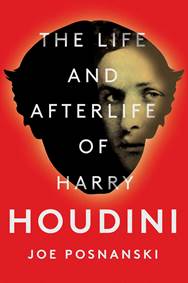
“Casey at the Bat” – Original Version: Earnest Lawrence Thayer wrote the iconic baseball poem “Casey at the Bat” in 1888. If you would like a reminder of the great lines, click here.
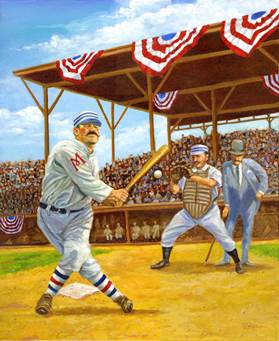
Thayer’s old-time baseball terms seem quaint as we listen to today’s broadcasters spouting sabermetrics – exit velocity, launch angle, WAR, spin rate, etc.
This has prompted Villanova professor Mitchell Nathanson to update the poem for the modern era. His version must be good – soon after it ran in the Washington Post, I received a copy from three Hot Stove readers (Mark Abels, Richard Martin and Fred Slough). Professor Nathanson is also the author of a forthcoming biography of pitcher and author Jim Bouton.
“Casey @ the Bat” – Sabermetrics Version: Casey today (“at the age of 31 the metrics deemed him old”)…
The outlook wasn’t brilliant for the Mudville nine that day;
The score stood four to two with but one inning more to play.
And then when Cooney whiffed again, the eighteenth K that night,
A sickly silence fell, for somehow baseball wasn’t right.
A straggling few got up and left, annoyed they even came;
And most who stayed were kind of drunk or wagered on the game.
Yet still to come was Casey, whom the fans had long extolled,
Though at the age of 31 the metrics deemed him old.
But first ahead of him was Flynn, a player much accursed;
His BABIP was atrocious, and his WAR was even worse.
Another guy came up as well, his name recalled by few;
Confusion sowed by double switches made in hour two.
But Flynn defied the numbers, making contact with the ball;
And sent it on a mighty arc — it caromed off the wall.
“The guy should be on third,” a salty graybeard spat and cursed,
As Flynn removed his batting gloves, a jogger still at first.
The other guy? A double by the waiver-wire addition;
(His former owner dumping salary without contrition);
And when the blaring music stopped, fans noticed what occurred,
Instead of crossing o’er the plate, young Flynn was still at third.
As Casey stepped into the box, the scoreboard roared “Make Noise!”;
The crowd most surely would’ve done, if not for all their toys.
About 5,000 hometown fans were checking in on Twitter;
So most remained oblivious to Casey as the hitter.
Ten thousand eyes were elsewhere as he scratched upon the dirt;
And Velcro-strapped his gloves and touched six places on his shirt.
And kissed his bat, then tapped the plate nine times or maybe 10;
Then from the box did Casey step, and start it all again.
The pitcher’s antics on the mound were also quite a show;
Whole seasons seemed to pass before he hinted at a throw.
Yet here it came, the cowhide sphere, arriving at great speed;
“Strike one,” the umpire firmly called, but PitchTrax disagreed.
The fans who watched it on their phones could see it plain: outside;
Unless their phones had zero bars, or batteries had died.
“Kill him! Kill the umpire!” the fans all stood and roared;
At least so roared the older ones, the younger ones seemed bored.
Two strikes remained. The oldsters, stressed, began to wring their hands;
While younger fans, in hour four, sped toward concession stands.
Then Casey dug in once again; the second spheroid flew;
But Casey still ignored it, and the umpire said, “Strike Two.”
“Fraud!” cried the maddened few at the blue-clad, rule-bound fools,
While waving off the heady clouds sent up from nearby Juuls.
Now, Casey’s face grew stern and cold, the fans all rose as one;
As midnight neared their hope was clear: just let the game be done.
As Casey runs the metrics, and adjusts his swing for lift;
The fielders check their little cards, and drift into a shift.
And now the pitcher fires a rocket off, despite his ample gut;
And now the air is shattered by great Casey’s uppercut.
Oh, somewhere in this favored land, the sport’s as it used to be;
And fans still hang on Casey’s fate, not exit velocity.
That era’s gone — don’t cry into your $15 beer;
While all the laughing children shout, “Football season’s here!”